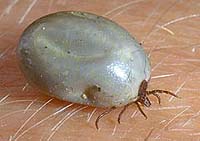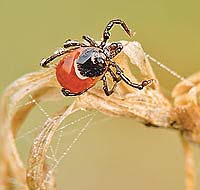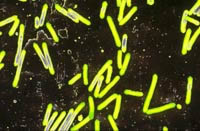Bittered tick. You have a strong head, muscle pain, lubrication in all body, pain in the stomach, nausea, redness of the face, bright red painting of lips, cracks in the corners of the mouth, finely point hemorrhagic rash by body. Urgently run to the doctor!
Content
A little about the pathogel
 «Crimean hemorrhagic fever (synonym: Congo-Crimean hemorrhagic fever, Central Asian hemorrhagic fever) - infectious disease characterized by natural foci, pronounced intoxication, the appearance of hemorrhages on the skin and mucous membranes, bleeding.
«Crimean hemorrhagic fever (synonym: Congo-Crimean hemorrhagic fever, Central Asian hemorrhagic fever) - infectious disease characterized by natural foci, pronounced intoxication, the appearance of hemorrhages on the skin and mucous membranes, bleeding.
The causative agent - RNA-containing the virus of the Bugherevirus family.
Sources of the causative agent of infection are cows, goats, as well as wild mammals. The reservoir and carriers of the virus are ixodic ticks (more than 20 species from the genus Hyalomma and some others;). The transfer of the pathogen occurs when the ticks are suited, as well as the blood of patients on the mucous membranes of the eyes, octopling, nasopharynx and damaged by the skin of people in contact with the patients (more often of medical staff).
Pretty people engaged in agricultural people, care for cattle, hay harvesting. The incidence is highest in the period of tick activity in May - June. Outside epidemics, the cases of Crimean hemorrhagic fever were observed in the southern regions of our country - Astrakhan, Rostov regions, Krasnodar, Stavropol Territories, as well as in Crimea. Abroad - in Central Asia, Balkan countries, Bulgaria, Hungary, India, Pakistan, a number of countries in Africa. It is possible to infect medical personnel when contacting the blood of the patient through the microtraums of the skin.
Manifestations of disease
The period from the penetration of the pathogen to the initial manifestations of the disease - 2 to 14 days, more often 3 - 5 days. The disease begins acutely with chills, increase temperatures up to 39-40°, General-toxic manifestations are dominated - headache, pain in muscles, weakness. Leather face, neck and top of the chest, conjunctivations, mucous membranes of zea hyperemic (redness). The development of hemorrhagic syndrome begins with the 3-6th day of the disease.
Usually it is preceded by a short-term decrease in temperature. Hemorrhagic rash appears (small hemorrhages) on the skin and mucous membranes, hemorrhage in injection places, nasal and gastrointestinal bleeding (or vomiting with blood, or disorder of stool with blood), uterine krvomenia, hematuria (with blood with urine), whose severity Often significant. Often marked nausea, vomiting, abdominal pain.
Perhaps the development of renal failure. Patients are injected, but can be excited. The period of recovery begins from the moment of normalization of temperature and cessation of bleeding (8-12th day of illness) and lasts several weeks.
The forecast is always serious, mortality up to 30%.
Disease definition
The establishment of the disease is based on the manifestations of the disease, epidemiological history data (stay in the zone of natural foci, attack of ticks, contact with sick fever of the Crimean-Congo), the results of laboratory studies.
Prevention and protection against fever
The basic measure of the warning of the Crimean hemorrhagic fever is to protect a person from the attack of ticks. For the individual protection of people working in endemic areas, protective clothing, protective nets, handle clothes with repellents; Self and intercessors are carried out every 1.5-2 hours and at the end of the work in order to detect and remove ticks.
Ixodic ticks (prevention issues and methods of struggle)
With the arrival of spring and the establishment of plus medium temperature temperatures begins a yield from the Ixodic ticks. They relate to temporary ectoparasites with long power and has a pasture-waiting type of attack, t.E. Located in a posture of its hosts among vegetation or on the surface of the soil bedding.
Man, being in open nature, is also an object of tick attack. At the approach of a person from the windward side, the tick female reacts from a distance of 15-20 meters. When attacking a man, the tick is crawling up and squeezed in open areas of the body. At the same time, some preferences are not detected to a certain place. This is based on individual defense methods - to leave the smallest part of the body.
Finding on open parts of the body, the tick moves for some time, and then begins to be sick. Singing time for different data ranges from 10 to 30 minutes. At the time of suction, the virus with saliva enters blood.
How to protect yourself from danger
 Going into the forest, leaving for the cottage, observe non-specific prevention measures: apply repellents on clothes and open areas of the body), which are in a wide range of assortment in pharmacies and economic departments of industrial stores.
Going into the forest, leaving for the cottage, observe non-specific prevention measures: apply repellents on clothes and open areas of the body), which are in a wide range of assortment in pharmacies and economic departments of industrial stores.
It is important to pay attention to the choice of clothing: give preference to light monophonic tissues, t.To. they are easier to notice a tick. Play shirt in pants, pants in socks. Desired tight high gates, dense cuffs, clasp type «lightning», Mandatory headdress.
During their nature, every hour has been able to carry out any hour. In the parks should go through the central parts of the paths. Before returning home, remove and shake the upper clothes. When returning to the apartment, take a shower, carefully inspect the body surface.
It is important to remember that ticks can be listed in residential premises together with bouquets of flowers, as well as on pet wool. If there was still a fact of suction of a tick, then you need to contact a medical institution to extract the parasite and conducting preventive measures.









